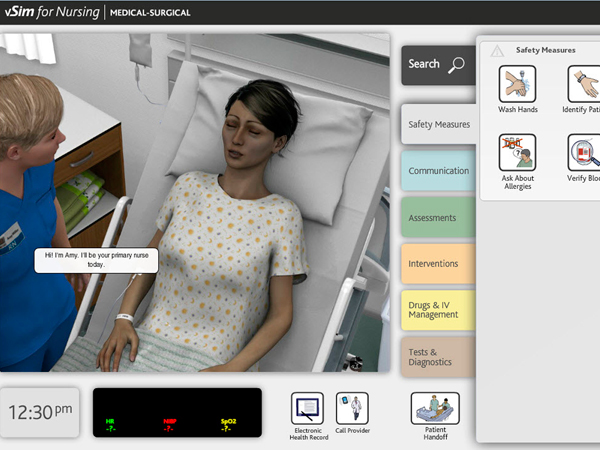Philadelphia Inquirer, Monday, June 16, 2014, Page A3, HEALTH/SCIENCE:
Teaching geriatric care to a new generation
A screen shot of a virtual scenario to train nurses in how to care for medical-surgical patients. The product from Wolters Kluwer Health is called vSim for Nursing.
George Palo is 90. He's repeating himself quite a bit these days and he's just had to downsize to a retirement community. He really misses his late wife.
Soon, he will also miss his beloved dog, Max.
This last bit of news caused a roomful of nurse educators to moan a sad, sympathetic, "Ohhhh" at a meeting last week at the Independence Blue Cross building in Center City.
George is a fictional character, created along with two others to help nurses in training understand dementia and its traveling companions among the elderly: depression and delirium.
"Traditional-based teaching is really over for most of us," Elaine Tagliareni, the league's chief program officer, told the crowd of about 175 who had gathered for her group's Advancing Care Excellence for Seniors conference. The Independence Blue Cross Foundation is a sponsor. Using technology to improve care was a theme this year.
The nursing group wants to reach a new generation of students who are already accustomed to multimedia learning, may be taking classes online, and will work in a world where technology increasingly connects patients, doctors, and nurses who are not in the same room.
Medical and nursing schools have long used standardized patients: actors who portray certain medical conditions. Increasingly sophisticated mannequins have been playing a bigger role in medical education in recent years.
Drexel University's College of Nursing and Health Professions began using a virtual-patient program produced by Shadow Health last year. It is meant to reinforce classroom training. The University of Pennsylvania School of Nursing also is using a Shadow Health program to teach nurses how to take a health history and perform a physical exam.
Gregg Lipschik, director of life-support training and undergraduate curriculum at the Penn Medicine Clinical Simulation Center, said Penn sometimes uses a virtual program to review resuscitation techniques. It pairs computer simulation and mannequins to teach procedures such as bronchoscopies.
Lipschik said use of simulation had been growing since 1999, when an Institute of Medicine report recommended it to reduce medical errors and improve teamwork. "It's really boomed in the last few years," he said.
The nursing league began its Advancing Care program in 2009, Tagliareni said, because "care of older adults is not well integrated into nursing programs" even though 75 percent of the care nurses give is to people over 65. It's adding the new dementia cases to expand education on another neglected topic.
The patient profiles are purposely complicated - like real people - and they unfold over time in unpredictable ways. The death of George Palo's golden retriever is a calamity not only because George's grief adds to his thinking problems but because walking Max was a key way the man exercised and interacted with the outside world. The profiles are accompanied by teacher information.
Tagliareni said that the dementia patients may not end up in the virtual world but that other fictitious elderly characters like Millie Larsen and Red Yoder may be available this fall in the gamelike "vSim for Nursing" program developed by Wolters Kluwer Health of Philadelphia and Laerdal Medical.
An audience member said her students easily identified with the league's patients. "That's my Pop-Pop," one of them told her.
The group at the meeting saw a younger virtual patient named Stan and his virtual nurse, Dan. Stan had gone to the emergency room with stomach pain from a bowel obstruction. The student, who had access to test information and doctor's orders, had to use a menu of options to decide what Dan should say and do. The animation was primitive, but the decisions were complex. At the end of their 30-minute encounter, the student received a number score and a report on what had been done and should have been done.
Barbara McLaughlin, head of nursing at Community College of Philadelphia, did a pilot test of vSim, which costs $100 per student for two years of access, with her students last year. "They liked them [the scenarios] a lot because it gave them the opportunity to do the same experience over and over and correct their mistakes," she said.
The league gets royalty payments for scenarios it creates for virtual simulation. The patient stories are free and available on its website, http://goo.gl/DU70Ci
sburling@phillynews.com
215-854-4944 @StaceyABurling
www.inquirer.com/health_science
Read more at http://www.philly.com/philly/health/20140616_Teaching_geriatric_care_to_a_new_generation.html#RLQSuA5H2C9yJIUH.99





No comments:
Post a Comment